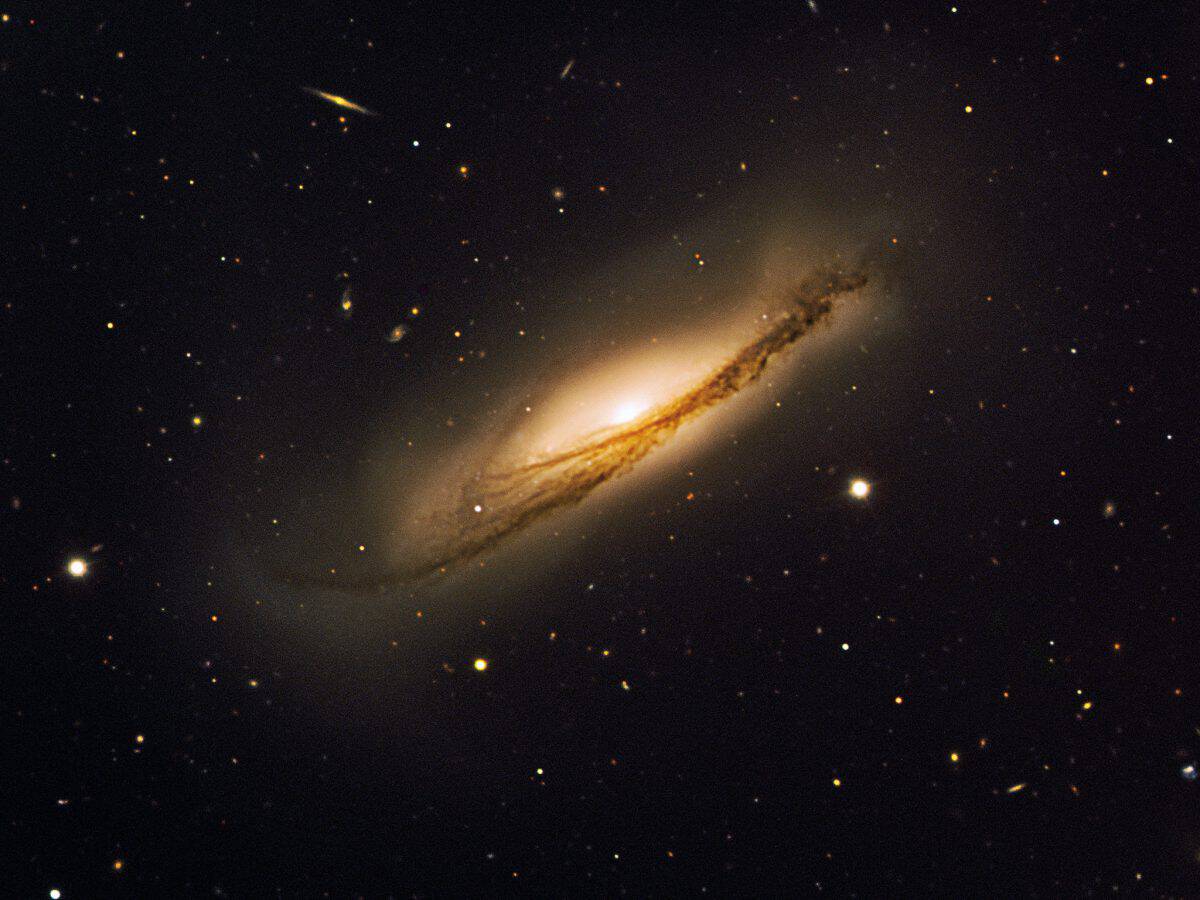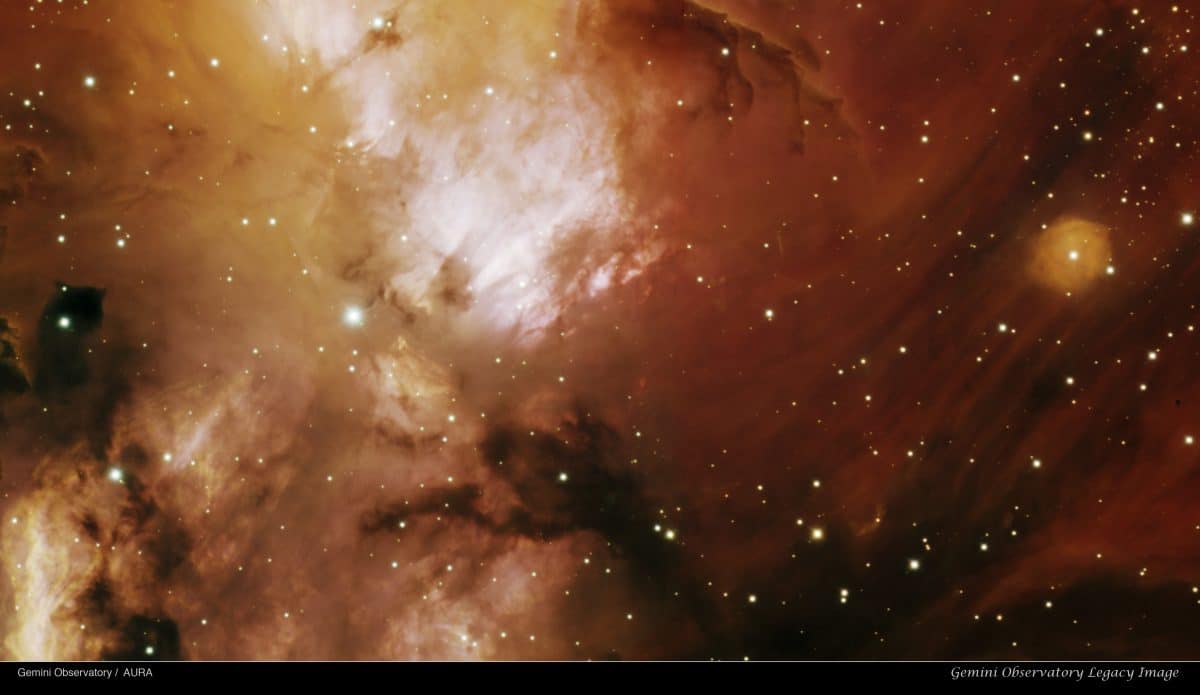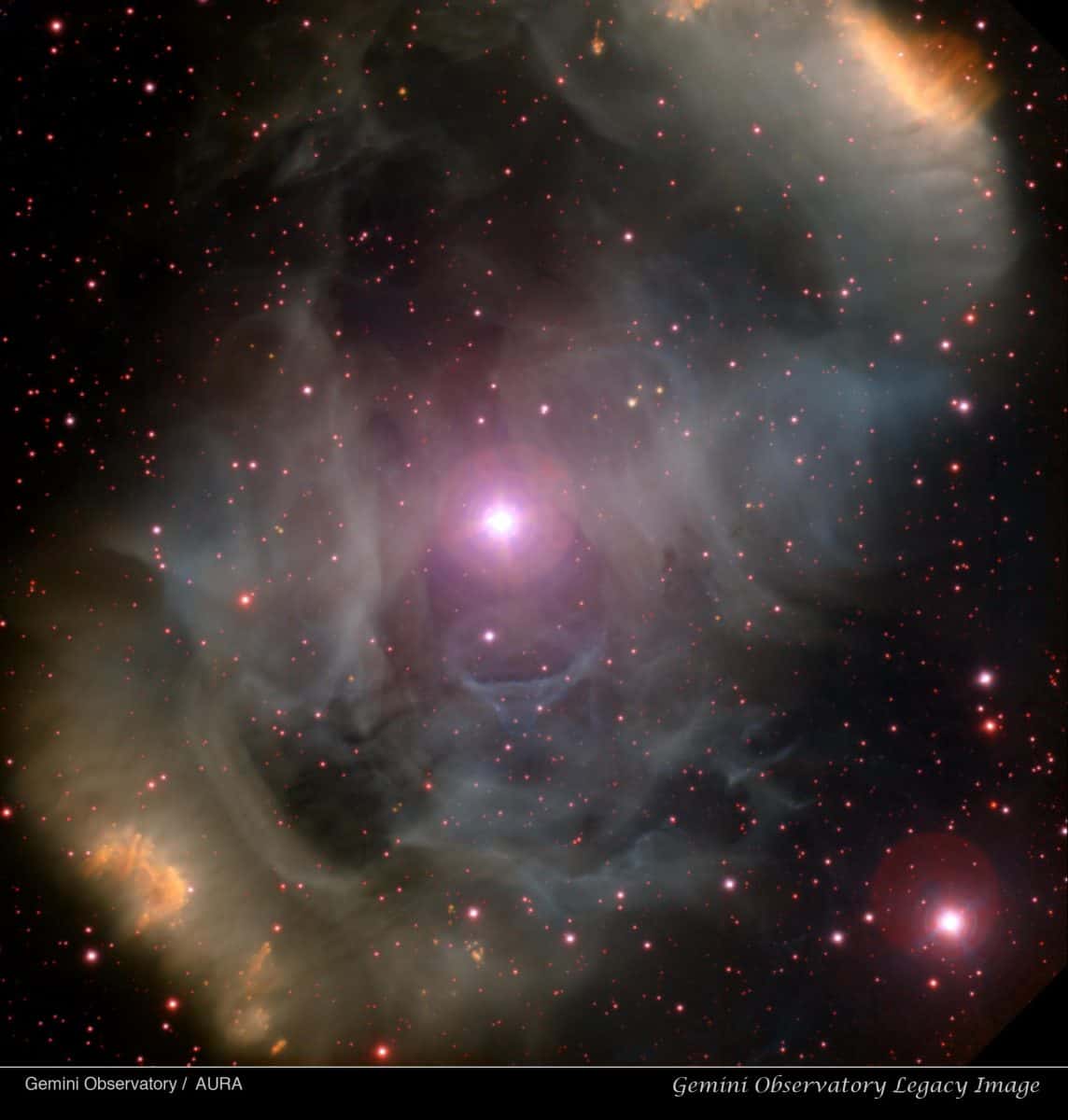Blog
The beautiful edge-on spiral galaxy NGC 3190 with tightly wound arms and a warped shape that makes it resemble a gigantic potato crisp, as seen by ESO’s Very Large Telescope. Supernova SN 2002bo is found in between the ‘V’ of the dust lanes in the south-western part of NGC 3190. SN 2002cv is obscured by a large amount of dust and is therefore not visible. Its position is however indicated on the above image. This colour composite is based on images obtained on 26 March 2003 with FORS1 on UT2 (Kueyen) in four filters (B, V, R and I) for a total exposure time of 14 minutes. The observations were done in the framework of a programme aiming at studying the physics of Type Ia supernovae. The field of view is 6.15 x 5 arcminutes. North is up and East is to the left. The data extraction from the archive, data reduction and final colour processing of the image was done by Henri Boffin (ESO).
NGC 3190 is a spiral galaxy with tightly wound arms and lying in the constellation Leo. It was discovered by William Herschel in 1784. NGC 3190 is member of Hickson 44 galaxy group, estimated at around 80 million light years away,[2] and consisting of four galaxies in a tight group – NGC 3193 is fairly featureless, NGC 3187 is a dim but striking spiral galaxy and NGC 3185 has a barred spiral structure with an outer ring.
In 2002 two supernovae were observed in the galaxy. A Brazilian amateur astronomer Paulo Cacella detected one supernova in the southeastern part in March 2002 (SN 2002bo), and then an Italian team, while studying the first one, detected a second supernova (SN 2002cv) on the other side two months later.
more...John Arthur “Jaki” Byard (June 15, 1922 – February 11, 1999) was an American jazz multi-instrumentalist, composer and arranger. Mainly a pianist, he also played tenor and alto saxophones, among several other instruments. He was known for his eclectic style, incorporating everything from ragtime and stride to free jazz.
Byard played with trumpeter Maynard Ferguson in the late 1950s and early 1960s, and was a member of bands led by bassist Charles Mingus for several years, including on several studio and concert recordings. The first of his recordings as a leader was in 1960, but, despite being praised by critics, his albums and performances did not gain him much wider attention. In his 60-year career, Byard recorded at least 35 albums as leader, and more than 50 as a sideman. Byard’s influence on the music comes from his combining of musical styles during performance, and his parallel career in teaching.
From 1969 Byard was heavily involved in jazz education: he began teaching at the New England Conservatory of Music and went on to work at several other music institutions, as well as having private students. He continued performing and recording, mainly in solo and small group settings, but he also led two big bands – one made up of some of his students, and the other of professional musicians. His death, from a single gunshot while in his home, remains an unsolved mystery.
Byard was born in Worcester, Massachusetts. At that time, his parents – John Sr and Geraldine Garr – were living at 47 Clayton Street. Both of his parents played musical instruments; his mother played the piano, as did his uncles and grandmother, the last playing in cinemas during the silent film era. He began piano lessons at the age of six, but they ended when his family was affected by the Great Depression.
more...Erroll Louis Garner (June 15, 1923 – January 2, 1977; some sources say b. 1921) was an American jazz pianist and composer known for his swing playing and ballads. His best-known composition, the ballad “Misty“, has become a jazz standard. Scott Yanow of Allmusic calls him “one of the most distinctive of all pianists” and a “brilliant virtuoso.” He received a star on the Hollywood Walk of Fame at 6363 Hollywood Blvd.
Born with his twin brother Ernest in Pittsburgh, Pennsylvania, to an African-American family on June 15, 1923, Erroll began playing piano at the age of three. His elder siblings were taught piano by Miss Bowman. From an early age, Erroll would sit down and play anything she had demonstrated, just like Miss Bowman, his eldest sister Martha said. He attended George Westinghouse High School, as did fellow pianists Billy Strayhorn and Ahmad Jamal. Garner was self-taught and remained an “ear player” all his life – he never learned to read music. At the age of seven, he began appearing on the radio station KDKA in Pittsburgh with a group called the Candy Kids. By the age of 11, he was playing on the Allegheny riverboats. At 14 in 1937, he joined local saxophonist Leroy Brown.
more...World Music on Flamenco Fridays with Paco Soto
Paco Soto, Águilas (1991). At the age of ten, he was given a guitar and five minutes later he said he wanted to be a flamenco guitarist; since then he got to the task. He has studied at the Cante de las Minas de la Unión Festival and the Cristina Heeren Foundation in Seville, with guitarists such as Gerardo Núñez and Miguel Ángel Cortés. Finally he moved to Madrid to study with Enrique Vargas and make room.
https://www.youtube.com/watch?v=05FxQvJ9l2w
more...At the heart of a star-forming region called RCW 57, this image shows the complex interaction of interstellar gas and dark dust clouds among newly formed stars. The glowing gas is energized by ultraviolet radiation from the young stars. The intricate wispy structures in the cloud are formed by radiation from the young stars and the explosions of nearby, very massive stars that have exceptionally short lives compared to stars like our sun. A study by M. Maercker in 2006 revealed that the region is overly abundant with massive star formation with over 33 star-forming regions in the extended area at the end stages of formation. This region of the sky is only visible from observers in the southern hemisphere and is a popular showpiece for small telescopes and binoculars in the far-southern constellation of Carina. The Gemini image was obtained with the Gemini Multi-Object Spectrograph at the Gemini South telescope using two pointings to make a mosaic image that has a field of view of 9.0 x 5.0 arcsminutes. The exposures were taken through three narrowband filters: [OIII] (blue), [SII] (green) and H-alpha (red).
more...
Marcus Miller (born William Henry Marcus Miller Jr.; June 14, 1959) is an American jazz composer, producer and multi-instrumentalist, best known as a bass guitarist. He has worked with trumpeter Miles Davis, pianist Herbie Hancock, singer Luther Vandross, and saxophonist David Sanborn, among others.
Miller was born in Brooklyn, New York City, in 1959 and raised in a musical family that includes his father, William Miller (a church organist and choir director) and jazz pianist Wynton Kelly. He is classically trained as a clarinetist and also plays keyboards, saxophone and guitar. He began to work regularly in New York City, eventually playing bass and writing music for jazz flutist Bobbi Humphrey and keyboardist Lonnie Liston Smith. Miller soon became a session musician, appearing on over 500 albums by such artists as Michael Jackson, Herbie Hancock, Mariah Carey, Wayne Shorter, McCoy Tyner, Frank Sinatra, George Benson, Dr. John, Aretha Franklin, Elton John, Joe Walsh, Grover Washington Jr., Donald Fagen, Bill Withers, Kazumi Watanabe, Chaka Khan, LL Cool J and Flavio Sala.
more...Kenny Drew Jr. (June 14, 1958 – August 3, 2014) was an American jazz pianist. His music is known for its hard-swinging bluesy sound and large, two-handed rooty chords contrasting with fast runs. The son of jazz pianist Kenny Drew, he did not credit his father as an influence.
His initial study was in classical music with his mother and grandmother. In his teens he became interested in jazz and pop, but initially worked in funk bands. Later he went into jazz piano and in 1990 won the Great American Jazz Piano competition in Jacksonville, Florida. Drew continued to perform jazz, but he also performed some chamber music. His style has some similarities to his father’s, but is different enough to generally avoid comparison; he was considered the more eclectic of the two men.
Drew attended Iona College in New Rochelle, New York, for a period during 1977 to 1978. There, he became pianist for the Iona College Singers, an entertainment troop promoting the college’s name and goodwill among local high schools, retirement homes and the like in the Northeast region of the USA.
Drew cited Thelonious Monk as an influence and like Monk often recorded (and performed) solo.
Drew died at home in St. Petersburg, Florida, on August 3, 2014
more...Autry DeWalt Mixon Jr. (June 14, 1931 – November 23, 1995), known by the stage name Junior Walker, styled as Jr. Walker, was an American musician. His group, Jr. Walker & The All Stars, were signed to Motown‘s Soul label in the 1960s, and became one of the company’s signature acts.
Walker was born Autry DeWalt Mixon Jr. in Blytheville, Arkansas, and grew up in South Bend, Indiana. His saxophone style was the anchor for the band’s overall sound. The other original members of the group were drummer Tony Washington, guitarist Willie Woods, and keyboardist Vic Thomas.
His career started when he developed his own band in the mid-1950s as the “Jumping Jacks.” His longtime friend Billy Nicks (1935–2017) (drummer) formed his own team, the “Rhythm Rockers.” Periodically, Nicks would sit in on Jumping Jack’s shows, and Walker would sit in on the Rhythm Rockers shows.
more...Amadu Bansang Jobarteh (kora, voice) was a jali: an oral historian and hereditary praise singer from among the Mandinka people of Gambia, West Africa. Amadu’s family background clearly illustrates the hereditary nature of jalis in West African society. In the late 1800s, and at the request of a Gambian chief, Amadu’s father Jali Fili Jobarteh emigrated from Mali and settled with his family in the town of Bansang. Although the father played koni, his children learned the kora, which was the favored instrument in that area of Gambia.
more...NGC 6164-5 imaged at Gemini South. The emission nebula NGC 6164-5 is a rectangular, bipolar cloud with rounded corners and a diagonal bar producing an inverted S-shaped appearance. It lies about 1,300 parsecs (4,200 light-years) away in the constellation Norma. The nebula measures about 1.3 parsecs (4.2 light-years) across, and contains gases ejected by the star HD 148937 at its heart. This star is 40 times more massive than the Sun, and at about three to four million years of age, is past the middle of its life span. Stars this massive usually live to be only about six million years old, so HD 148397 is aging fast. It will likely end its life in a violent supernova explosion.
more...Attila Cornelius Zoller (June 13, 1927 – January 25, 1998) was a jazz guitarist born in Hungary. After World War II, he escaped the Soviet takeover of Hungary by fleeing through the mountains on foot into Austria. In 1959, he moved to the U.S., where he spent the rest of his life as a musician and teacher.
Zoller was born in Visegrád, Hungary in 1927. As a child, he learned violin from his father, a professional violinist. While in school, he played flugelhorn and bass before choosing guitar. He dropped out of school and played in jazz clubs in Budapest while Russia occupied Hungary. He fled Hungary in 1948 as the Soviet Union was establishing communist military rule. He escaped on foot, carrying his guitar through the mountains into Austria. He settled in Vienna, became an Austrian citizen, and started a jazz group with accordionist Vera Auer.
In the 1950s, Zoller moved to Germany and played with German musicians Jutta Hipp and Hans Koller. When American jazz musicians passed through, such as Oscar Pettiford and Lee Konitz, they persuaded him to move to the United States. He moved to the U.S. after receiving a scholarship to the Lenox School of Jazz. One of his teachers was guitarist Jim Hall and his roommate was Ornette Coleman, who got him interested in free jazz.
more...Wild Bill Moore (born William M. Moore, June 13, 1918 – August 1, 1983) was an American R&B and jazz tenor saxophone player. Moore earned a modest hit on the Hot R&B charts with “We’re Gonna Rock, We’re Gonna Roll”, which also was one of the earliest rock and roll records.
Moore was born in Detroit Michigan and began playing the alto saxophone at an early age. However, prior to his musical career, he was an amateur boxer, winning Michigan’s Golden Gloves light heavyweight championship in 1937, before briefly turning professional. By the early 1940s, Moore abandoned his boxing career in favor of music, and was inspired by musicians Chu Berry and Illinois Jacquet to switch to tenor saxophone. In 1944, he made his recording debut, accompanying Christine Chatman, the wife of Memphis Slim, for Decca Records. Between 1945 and 1947, Moore was performing and recording in Los Angeles with Slim Gaillard, Jack McVea, Big Joe Turner, Dexter Gordon, and played on Helen Humes’ hit recording, “Be-Baba-Leba”
more...Adolphus Anthony Cheatham, better known as Doc Cheatham (June 13, 1905 – June 2, 1997), was a jazz trumpeter, singer, and bandleader.
After having played in some of the leading jazz groups from the 1920s on, Cheatham enjoyed renewed acclaim in later decades of his career. He himself agreed with the critical assessment that he was probably the only jazz musician to create his best work after the age of 70.
Cheatham was born in Nashville, Tennessee of African, Cherokee and Choctaw heritage. He noted there was no jazz music there in his youth; like many in the United States he was introduced to the style by early recordings and touring groups at the end of the 1910s. He abandoned his family’s plans for him to be a pharmacist (although retaining the medically inspired nickname “Doc”) to play music, initially playing soprano and tenor saxophone in addition to trumpet in Nashville’s African American Vaudeville theater. Cheatham later toured in band accompanying blues singers on the Theater Owners Booking Association circuit. His early jazz influences included Henry Busse and Johnny Dunn, but when he moved to Chicago in 1924 he heard King Oliver. Oliver’s playing was a revelation to Cheatham. Cheatham followed the jazz King around. Oliver gave young Cheatham a mute which Cheatham treasured and performed with for the rest of his career. A further revelation came the following year when Louis Armstrong returned to Chicago. Armstrong would be a lifelong influence on Cheatham.
more...Slonovski Bal plays the sounds of the central European Balkans, blending the music of the Gypsies with a unique mix of European, Slavic, Turkish and Mediterranean cultures, representing the fine tradition of the oriental brass band music. Slonovski bal means “the Elephant’s Ball” in Serbian.
more...NGC 660 is classified as a “polar ring galaxy“, meaning that it has a belt of gas and stars around its centre that it ripped from a near neighbour during a clash about one billion years ago. The first polar ring galaxy was observed in 1978 and only around a dozen more have been discovered since then, making them something of a cosmic rarity.
Unfortunately, NGC 660’s polar ring cannot be seen in this image, but has plenty of other features that make it of interest to astronomers – its central bulge is strangely off-kilter and, perhaps more intriguingly, it is thought to harbour exceptionally large amounts of dark matter. In addition, in late 2012 astronomers observed a massive outburst emanating from NGC 660 that was around ten times as bright as a supernova explosion. This burst was thought to be caused by a massive jet shooting out of the supermassive black hole at the centre of the galaxy.
more...Peter Beets (born 12 June 1971) is a Dutch jazz pianist. He has shared the stage with musicians including Chick Corea, Wynton Marsalis, Dee Dee Bridgewater, George Coleman, Johnny Griffin, Chris Potter, Kurt Rosenwinkel and John Clayton. Beets recorded with Jeff Hamilton and Curtis Fullerand in 2001 he released his New York Trio, which was the start of his international career.
Beets was born in The Hague on 12 June 1971. His mother is a music teacher and his father a jazz-playing gynaecologist with a love of Oscar Peterson and Art Blakey. This musical family, which includes two elder brothers, Marius and Alexander, moved in 1972 to Groenlo.
more...Armando Anthony “Chick” Corea (born June 12, 1941) is an American jazz pianist/electric keyboardist and composer. His compositions “Spain“, “500 Miles High“, “La Fiesta” and “Windows“, are considered jazz standards. As a member of Miles Davis‘s band in the late 1960s, he participated in the birth of jazz fusion. In the 1970s he formed the fusion band Return to Forever. With Herbie Hancock, McCoy Tyner, and Keith Jarrett, he has been described as one of the major jazz piano voices to emerge in the post-John Coltrane era.
Corea continued to pursue other collaborations and to explore musical styles throughout the 1980s and 1990s. He is also known for promoting and fundraising for a number of social issues.
Armando Corea was born in Chelsea, Massachusetts. He is of southern Italian and Spanish descent. His father, a jazz trumpeter who led a Dixieland band in Boston in the 1930s and 1940s, introduced him to the piano at the age of four. Surrounded by jazz, he was influenced at an early age by bebop and Dizzy Gillespie, Charlie Parker, Bud Powell, Horace Silver, and Lester Young. At eight he took up drums, which would influence his use of the piano as a percussion instrument.
more...More Posts
- Tim Buckley
- Maceo Parker
- Merl Saunders
- Dwike Mitchell
- World Music with Meklit Hadero
- Daily Roots with Bob Marley
- Surviving the Pandemic and Realizing Racial Justice
- The Cosmos with NGC 6902
- Peter Gabriel
- King Floyd
- Rebop Kwaku Baah
- Wardell Gray
- World Music with Tartit
- Daily Roots with R Zee Jackson
- Abraham Lincoln Day 2021
- Happy Lunar New Year 2021
- Surviving the Pandemic and Realizing Racial Justice
- The Cosmos with NGC 1350
- Narasimhan Ravikiran
- Omar Hakim



